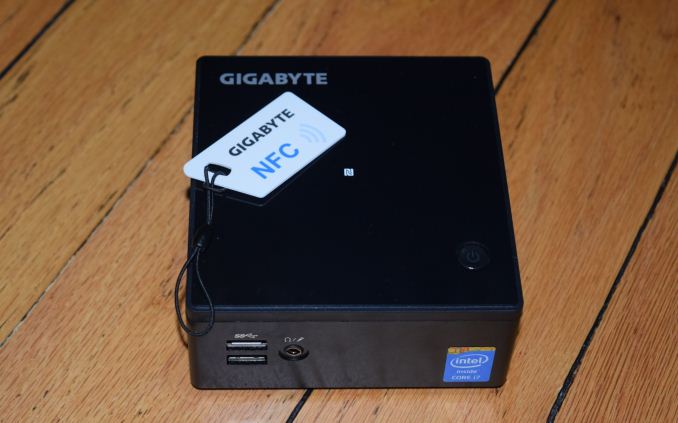GIGABYTE GB-BXi7H-5500 Broadwell BRIX Review
by Ganesh T S on January 29, 2015 7:00 AM ESTFinal Words
The GIGABYTE GB-BXi7H-5500 provided us with the opportunity to take a look at what Broadwell-U can deliver. The migration from 22nm to 14nm has allowed for higher base clocks while maintaining the same power envelop. The performance delta over the Haswell-U-based GB-BXi7-4500 (particularly, on the graphics side) is notable. That said, while migrating from Sandy Bridge or Ivy Bridge is a no-brainer, there is not enough on offer to recommend migrating from a Haswell-based mini-PC.
From the perspective of the BRIX itself, the GB-BXi7H-5500 has two major downsides, and both of them are related to the networking subsystem. Considering that the i7 SKU is the 'premium' SKU in this lineup, use of a 1x1 802.11ac (Intel AC3160) card is disappointing. It would have been nice to have the AC7260 or AC7265. The Broadcom BCM4352 is even more preferable. In addition, GIGABYTE should have opted for an Intel LAN chipset instead of a Realtek one for this high-end configuration.
One of the interesting differentiating features is the availability of NFC. Along with the unit, GIGABYTE also supplied a NFC tag. The accompanying driver DVD has a NFC app (Windows program) which allows creation of profiles to link with the tag. These profiles could be associated with web addresses or files / programs in the system. Tapping the tag against the unit's lid activates the profile. Right now, this is a basic application. GIGABYTE indicated that they are working on bringing more functionality to the app and making it easier to use.
The pricing of the Core i7-5500U makes it attractive for high-end ultrabooks, but the BXi7H-5500 manages to get it to the consumer in a UCFF PC at a reasonable price ($509, when Intel apparently sells the CPU alone for $393). All in all, GIGABYTE has managed to deliver the right balance of price, power, size and thermal / acoustic design in the GB-BXi7H-5500. It remains to be seen what Intel is able to offer with the NUC lineup and how the NUCs will complement and/or compete against the Broadwell BRIX units.











53 Comments
View All Comments
cobalt42 - Friday, January 30, 2015 - link
I think you're actually kind of agreeing -- as implied by the OP, 1366x768 is closer to 1280x720 than it is to 1280x1024. (768p is 80% of 12x10, 720p is 70% of 12x10). Either way, 1280x1048 is rather too many pixels.milkod2001 - Thursday, January 29, 2015 - link
This seems more reasonable build compared to ASrock a few days back you posted review about. But Im still not sold on temperatures it reaches. 90c is way too much. Looks like even Broodwell could not help. Problem must be the case, it's just way too small.My suggestion to vendors would be to completely ignore Intel's NUC standard build entirely and put everything into bigger aluminium case Apple mini like.
milkod2001 - Thursday, January 29, 2015 - link
in other words, clone Apple mini, make RAM + SSD upgradable and slap windows OS on that. Then we talk.nwrigley - Thursday, January 29, 2015 - link
I haven't seen anything that comes close to the Mac Mini on an engineering level. It's a real shame too, the Mac Mini has been out for 10 years and nothing has bested that design.I hope we start to see some more innovation. If you go a step above the Mac Mini in size/weight/performance you've probably doubled your size and weight (at least). I wish they would make parts for systems larger than a laptop, but smaller than a tower. I would gladly trade off some of the size and weight of the Mini for more performance.
Kalessian - Thursday, January 29, 2015 - link
This review hit my browser like a sack of brix. Thx.ericgl21 - Thursday, January 29, 2015 - link
This i7-5500U is not impressive at all.Even now with 14nm, a 15W CPU (with iGPU) from Intel still doesn't cut it.
Hopefully, Intel will release a proper quad-core CPU that would take on the i7-4770R in all respects, including a lower TDP.
BlueBlazer - Thursday, January 29, 2015 - link
Getting close and often surpassing AMD mobile APU offerings that has higher TDPs. Source of comparisons http://www.anandtech.com/show/8119/amd-launches-mo... and http://www.anandtech.com/show/7106/amds-a105750m-r... Although differrent resolutions, 1280x1024 has more pixels than 1366x768. Furthermore not forgetting that this Core i7 5500u is just a 15W part!Hulk - Thursday, January 29, 2015 - link
Not that I don't appreciate this fantastic review but are we going to see a Broadwell review?Specifically:
Broadwell, Haswell, Ivy, and Sandy with clocks normalized so we can see IPC improvements Work normalized so we can see a few generations of power efficiency improvements?
And finally head-to-head for each iGPU (with games and compute benches)?
TheinsanegamerN - Thursday, January 29, 2015 - link
Looks good. cant wait to pick up the hd 6000 varient. I may have missed it, but does the broadwell NUC allow for the TDP to be raised like the haswell ones did? that, combined with 2133 memory let hd 5000 stretch its legs and perform quite well. hd6000 would be even better.kgh00007 - Thursday, January 29, 2015 - link
Yeah I hope so! I have raised the TDP on my D54250WYK to 25W and also have 2133 RAM, makes a big difference in performance over 15W TDP and 1600 RAM in games!!